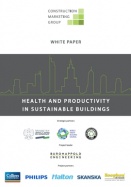Health and productivity in sustainable buildings
In June 2015, the Construction Marketing Group (CMG) published, a white paper, 'Health and Productivity in Sustainable Buildings', part of a research project on sustainable buildings in Poland. The project was initiated by --Buro Happold Engineering and builds on a report 'Health, Wellbeing and Productivity in Offices' published by the World Green Building Council (WGBC) in 2014.
The purpose of the White Paper was to '…encourage businesses to investigate the real impact their buildings have on their people.'
It aims to raise business awareness of the positive impact of sustainable buildings and the possible financial benefits. It is intended for investors, business leaders, tenants and real estate agents.
The project consisted of two phases.
The first phase analysed market perceptions of sustainable buildings. The second phase attempted to answer the following questions:
- Why and how should businesses measure the impact of their buildings on their people?
- What common approach should we apply in the local market?
- How does the global framework presented by the World Green Building Council apply to the Polish market?
The main conclusions of the paper were that:
- Sustainable buildings are not only more energy efficient but are also able to improve the wellbeing and efficiency of the people working in them.
- It is necessary and feasible for businesses to measure the impact of their buildings on their employees. Most of the data needed will have already been collected or will be relatively easy to access. What needs to be addressed, is how buildings influence people's health, wellbeing at work and subsequent productivity.
- The overall organisational measurement framework proposed by the WGBC and analysed as part of the project can be adopted as a regular approach for the Polish market.
- Multiple studies show that sustainable design is key to success. Investors need to ensure that elements such as indoor air quality, light quality, acoustic comfort, spatial configuration, biophilia (the tendency for people to seek connections with nature), views and access to amenities are adequately addressed.
Ian Booth, partner at Buro Happold said, “This is a ground breaking moment for the Polish market and the first time that such a large group of experts from numerous organisations has been engaged in verifying a global methodology regarding the influence buildings have on their users. Members of the technical committee analysed and defined the issue, underlining the fact that there is a global solution that can be successfully applied to the Polish market.”
Katarzyna Chwalbiska-Kusek, marketing and business development manager, Buro Happold said, “On average, we spend 90% of our time indoors, so interior environments have a great influence on both our health and wellbeing. Modern, sustainable offices are equipped with numerous solutions reducing negative effects, for example, by applying better ventilation systems, ensuring better access to natural daylight and creating relaxation zones. Our aim is to encourage the market to conduct integrated research that will help reflect the real influence of sustainable buildings on employees' health and productivity.”
[edit] Related articles on Designing Buildings Wiki
- Access and inclusion in the built environment: policy and guidance.
- Access consultant.
- Accessible London.
- Biophilic design.
- Biophilic design and sustainability.
- Biophilic design - health and wellbeing in buildings.
- Biophilic design - why it matters.
- Changing lifestyles.
- Cycling and walking plan.
- Equality act.
- Inclusive design.
- Light pollution.
- Smart cities.
- Sustainability
- Sustainable materials.
- Wellbeing
Featured articles and news
RTPI leader to become new CIOB Chief Executive Officer
Dr Victoria Hills MRTPI, FICE to take over after Caroline Gumble’s departure.
Social and affordable housing, a long term plan for delivery
The “Delivering a Decade of Renewal for Social and Affordable Housing” strategy sets out future path.
A change to adoptive architecture
Effects of global weather warming on architectural detailing, material choice and human interaction.
The proposed publicly owned and backed subsidiary of Homes England, to facilitate new homes.
How big is the problem and what can we do to mitigate the effects?
Overheating guidance and tools for building designers
A number of cool guides to help with the heat.
The UK's Modern Industrial Strategy: A 10 year plan
Previous consultation criticism, current key elements and general support with some persisting reservations.
Building Safety Regulator reforms
New roles, new staff and a new fast track service pave the way for a single construction regulator.
Architectural Technologist CPDs and Communications
CIAT CPD… and how you can do it!
Cooling centres and cool spaces
Managing extreme heat in cities by directing the public to places for heat stress relief and water sources.
Winter gardens: A brief history and warm variations
Extending the season with glass in different forms and terms.
Restoring Great Yarmouth's Winter Gardens
Transforming one of the least sustainable constructions imaginable.
Construction Skills Mission Board launch sector drive
Newly formed government and industry collaboration set strategy for recruiting an additional 100,000 construction workers a year.
New Architects Code comes into effect in September 2025
ARB Architects Code of Conduct and Practice available with ongoing consultation regarding guidance.
Welsh Skills Body (Medr) launches ambitious plan
The new skills body brings together funding and regulation of tertiary education and research for the devolved nation.
Paul Gandy FCIOB announced as next CIOB President
Former Tilbury Douglas CEO takes helm.
UK Infrastructure: A 10 Year Strategy. In brief with reactions
With the National Infrastructure and Service Transformation Authority (NISTA).
























